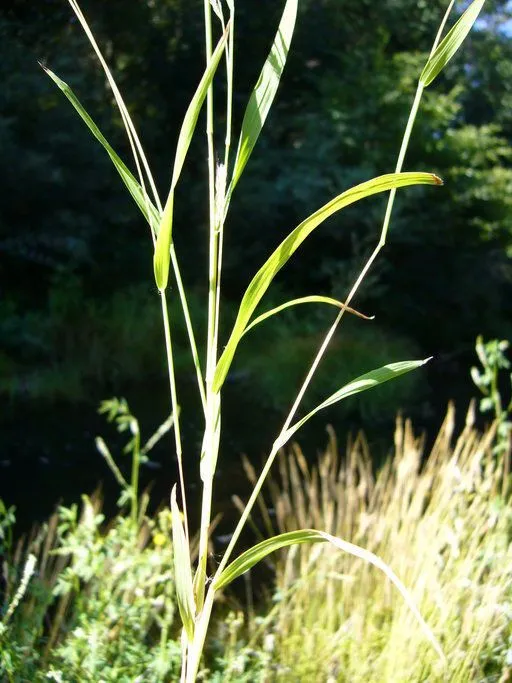
Author: (L.) Trin.
Bibliography: Gram. Unifl. Sesquifl.: 189 (1824)
Year: 1824
Status: accepted
Rank: species
Genus: Muhlenbergia
Vegetable: False
Observations: N. America to NE. Mexico
Mexican muhly, scientifically known as Muhlenbergia mexicana, is a graceful and versatile grass belonging to the family Poaceae. Originally documented in 1824, this species showcases the vast biodiversity of North America, extending as far south as northeastern Mexico.
Mexican muhly thrives in varied environments, contributing to its widespread distribution. You may find it flourishing in open meadows, prairies, and alongside water bodies, where it plays a crucial role in the ecosystem. This perennial grass typically exhibits a dense clump-forming habit with slender, arching leaves that create a delicate, feathery appearance.
In terms of physical characteristics, Mexican muhly stands out with its fine-textured, vibrant green foliage that turns into striking hues of gold and purple in the fall. The plant’s inflorescence is composed of soft, airy spikes that emerge in late summer, providing a captivating display that enhances both natural landscapes and cultivated gardens.
The adaptability of Mexican muhly makes it an excellent choice for gardeners and landscapers looking to incorporate native plants into their designs. It is tolerant of a range of soil types and performs well in both full sun and partial shade conditions. Additionally, its low maintenance requirements and drought resistance once established make it an ideal candidate for sustainable landscaping practices.
Beyond its ornamental appeal, Mexican muhly serves important ecological functions. It provides habitat and food for various wildlife, including insects and small mammals. Its deep root system helps prevent soil erosion and improves soil structure, promoting healthier and more resilient ecosystems.
In summary, Muhlenbergia mexicana, or Mexican muhly, is a valuable and attractive grass species that offers numerous benefits for natural and cultivated landscapes. Its elegance, adaptability, and ecological importance underscore its role as a key component of North American flora.
Eng: mexican muhly, wirestem muhly, mexican satingrass, wire-stemmed muhly
Deu: mexikanische mühlenbergie
Dan: myretæppe
Swe: mexikanskt muhlygräs
Nld: satijngras
Fra: muhlenbergie du mexique, muhlenbergia du mexique, muhlenbergie mexicaine
En: Mexican muhly, Wirestem muhly, Mexican satingrass, Wire-stemmed muhly
Da: Myretæppe
Nl: Satijngras
Et: Mehhiko muulahein
Fr: Muhlenbergie du Mexique, Muhlenbergia du Mexique, Muhlenbergie mexicaine
De: Mexikanische Mühlenbergie
Sv: Mexikanskt muhlygräs
Taken Aug 29, 2009 by EOL − Zoya Akulova (cc-by-nc)
Taken Aug 29, 2009 by EOL − Zoya Akulova (cc-by-nc)
Taken Aug 29, 2009 by EOL − Zoya Akulova (cc-by-nc)
© copyright of the Board of Trustees of the Royal Botanic Gardens, Kew.
Growth form>: Rhizomatous
Growth habit>: Graminoid
Growth rate>: Moderate
Ph maximum: 7.5
Ph minimum: 5.5
Family: Myrtaceae Author: (F.Muell.) K.D.Hill & L.A.S.Johnson Bibliography: Telopea 6: 402 (1995) Year: 1995 Status:…
Family: Rubiaceae Author: Pierre ex A.Froehner Bibliography: Notizbl. Bot. Gart. Berlin-Dahlem 1: 237 (1897) Year:…
Family: Sapindaceae Author: Koidz. Bibliography: J. Coll. Sci. Imp. Univ. Tokyo 32(1): 38 (1911) Year:…
Family: Asteraceae Author: A.Gray Bibliography: Pacif. Railr. Rep.: 107 (1857) Year: 1857 Status: accepted Rank:…
Family: Fabaceae Author: Medik. Bibliography: Vorles. Churpfälz. Phys.-Ökon. Ges. 2: 398 (1787) Year: 1787 Status:…
Family: Aspleniaceae Author: (Cav.) Alston Bibliography: Bull. Misc. Inform. Kew 1932: 309 (1932) Year: 1932…